

Original Article - Year 2015 - Volume 30 - Issue 3
Publication involvement of plastic surgery residents in accredited services: A 10-year comparative analysis
Publicação dos residentes de cirurgia plástica em serviços credenciados - análise comparativa de 10 anos
ABSTRACT
INTRODUCTION: Conducting research and publishing articles during residency are not mandatory yet. However, these are shown to be necessary during training. This study aimed to evaluate the participation of resident physicians from services accredited by the Brazilian Society of Plastic Surgery in the publication of articles in the Brazilian Journal of Plastic Surgery by analyzing how they have evolved over a period of 10 years.
METHODS: We evaluated articles published in the Brazilian Journal of Plastic Surgery between 2003 and 2012, excluding editorial, letter, message, erratum and acknowledgment articles. We also evaluated data regarding sex, demographic region, type of work, number of papers published with the participation of residents, mean number of residents per publication, subject area, and educational institution.
RESULTS: We identified 204 articles, of which 53 were published between 2003 and 2007, and 151 were published between 2008 and 2012. The most common subject was body contour, accounting for 95.1% of descriptive studies. Most of the authors were not affiliated with higher institutions (54.4%), and the residents from the southeast region were most active participants. On comparing different periods, we observed an increase in the number of residents as authors and in the participation of residents. The number of articles increased significantly in all regions of the country, except in the south.
CONCLUSION: The participation of residents in the publication of scientific articles that were published in the last 5 years in the southeast, northeast, and midwest regions has increased. The training structure for resident physicians should be improved to increase scientific publication in both, quantitative and qualitative aspects.
Keywords: Authorship and co-authorship in scientific publication; Medical residency; Plastic surgery.
RESUMO
INTRODUÇÃO: O desenvolvimento de pesquisas e a publicação de artigos durante o período de residência médica ainda não é obrigatório, porém tem sido evidenciada a sua necessidade durante a formação. Este estudo tem como objetivo fazer uma avaliação com relação à participação de médicos residentes dos serviços reconhecidos pela SBCP na publicação de artigos na Revista Brasileira de Cirurgia Plástica, comparando a evolução destes em um período de 10 anos.
MÉTODOS: Foram avaliados artigos publicados na Revista Brasileira de Cirurgia Plástica no período de 2003-2012, excluindo artigos relacionados a editoriais, carta, mensagem, erratas e agradecimentos. Foram avaliados dados como: sexo, região demográfica, tipo de trabalho, número de trabalhos publicados com participação de residentes, média de residentes por publicação, área temática, instituição de ensino.
RESULTADOS: Foram identificados 204 artigos, sendo 53 no período de 2003-2007 e 151 artigos de 2008-2012. O tema mais comum foi o contorno corporal, com 95,1% em estudos descritivos. A maioria dos autores não tinha vínculo com instituição superior (54,4%), sendo a região demográfica mais participante a Sudeste. Quando comparados os períodos, houve aumento de residentes como autores, na participação dos residentes e o número de artigos cresceu significativamente em todas as regiões do país, exceto na região Sul.
CONCLUSÃO: Houve aumento na participação de residentes da produção de artigos científicos publicados nos últimos 5 anos nas regiões Sudeste, Nordeste e Centro-Oeste. Existe necessidade de aperfeiçoamento na estrutura de formação do médico residente para melhorar a produção científica, seja nos aspectos quantitativos ou qualitativos.
Palavras-chave: Autoria e coautoria na publicação científica; Residência médica; Cirurgia plástica.
Brazilian services of medical residency are validated by the Ministry of Education and Brazilian Society of Plastic Surgery (BSPS). During medical training in plastic surgery, physicians are provided the opportunities to acquire clinical and surgical knowledge from the initial history of the patient to postoperative follow-up, to study and gain qualification in different surgical techniques, to develop skills in detecting patients who are candidates for surgery, to gain efficaciousness in case of emergency care and plastic surgery emergency, and to develop research activities1-3.
Performing research and publishing articles during the period of medical residency has not been made mandatory till date. However, in many countries, this has been shown to be necessary during the evolution of the plastic surgeon for the improvement and evolution of evidence-based medicine.
OBJECTIVE
To perform multivariate statistical evaluation regarding the participation of medical residents from services recognized by the BSPS in the publication of articles in the Brazilian Journal of Plastic Surgery by assessing their evolution over a period of 10 years.
METHODS
We selected articles published in the Brazilian Journal of Plastic Surgery from 2003 to 2012, excluding editorial, letter, message, debates, errata, and acknowledgment articles. The study included articles from plastic surgery services that are currently accredited by the BSPS and involved the participation of residents, interns, and aspirant members in plastic surgery.
We evaluated data such as sex, demographic region of accredited services, type of work, number of papers published with the participation of residents, mean number of residents per publication, subject area of the article, and accredited service of the education institution. These data were then compared by evaluating two different periods, namely from 2003 to 2007 and from 2008 to 2012.
RESULTS
We identified 204 articles, of which 53 (26.0%) were published in the first period (2003-2007) and 151 (74%) were published in the second period (2008-2012). Of these, 194 (95.1%) were descriptive, 5 (2.5%) were analytical, and 5 (2.5%) were experimental studies. The most common topics addressed in plastic surgery were body contour (42/20, 6%), the face (35/17, 2%), tumors (14/6, 9%), flaps and microsurgeries (13/6, 4%), hand, rhinoplasties, post-bariatric management, wounds and dressings, burns, body contour, experimental (111/33, 7%) plastic surgery, and others (31/15, 2%).
The authors were affiliated with several institutions that were categorized as institutions of higher education (n = 93 articles, 45.6%) and non-teaching institutions (n = 111 articles, 54.4%). Of the total number of articles (n = 204), 138 (67.6%) were related to the type of reconstructive surgery; 50 (24.5%), to aesthetic procedures; and 16 (7.8%), to others. The region of Brazil with the highest number of articles published (2003-2012) was the southeast region (158-77.5%), whereas the lowest was the south (10-4.9%; Table 1). In the first and second periods evaluated, the southeast region remained the area with the highest proportion of articles published (p < 0.001; Table 2).
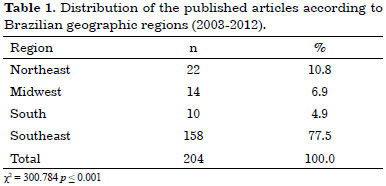
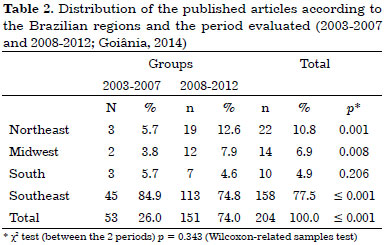
Regarding the participation of the residents per article, 88 articles (43.1%) involved the participation of only one resident, of whom 61 (69.3%) were men; 58 articles (28.4%), the participation of 2 residents, of whom 56 (96.4%) were men; 30 articles (14.7%), the participation of 3 residents, of whom 30 (85.5%) were men; and 28 articles (13.7%), the participation of 4 or more residents, all of whom were men. The mean number of resident participations per article was 2.11 ± 1.47. The number of resident authors increased from 4 (6.8%) in the first period evaluated to 55 (93.2%) in the second period evaluated (p < 0.001; Figure 1).
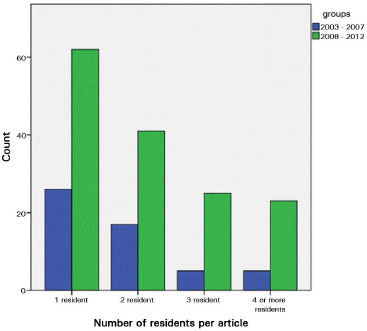
Figure 1. Distribution of the number of articles published according to the Brazilian regions and the periods evaluated (Goiânia, 2014).
The number of articles published increased proportionally in all of the regions, except the south, where the increase was not significant (Figure 2). The participation of residents in the publication of articles and the number of articles increased significantly (p < 0.001). In the evaluation of the entire study period, no difference was observed in the participation of different institutions over the period of 10 years. The number of articles from higher education institutions was 93 (45.6%), and that of articles from non-teaching institutions was 111 (54.4%; c2 = 1.588, p = 0.208; Table 3).
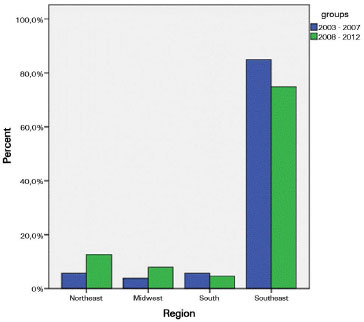
Figure 2. Distribution of the number of residents per item according to the period evaluated (Goiânia, 2014).
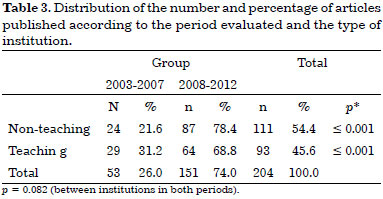
The number of published articles from educational institutions increased from 29 in the first period to 64 in the second period (p < 0.001). The number of published articles from non-exclusively-teaching institutions also increased from 24 in the first period to 87 in the second period (p < 0.001; Table 3).
Among the authors of all of the articles, 97 (54.27%) were affiliated with higher education institutions (public or private) and 130 (57.3%) were affiliated with hospitals that did not present the characteristics necessary to be considered a higher-education institution. By using the Wilcoxon test for related samples (p < 0.001), a significant increase in the production rate was observed in all of the regions, from the first to the second period. The region with the lowest increase in production was the southern area, whereas that with the highest increase was the northeast region, followed by the midwest. By using a coefficient that divided the number of publications by the number of accredited services in the region, we obtained an increased production in all of the regions. However, only the southern region presented an increase that was less than 1 (Table 4).
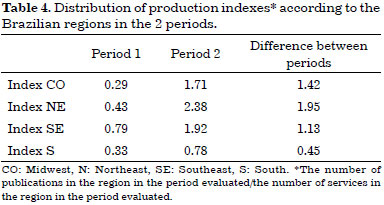
DISCUSSION
The current total number of services of medical residency in plastic surgery that are accredited by the BSPS is 84. The evolution of residents as medical specialists should be guided by the best ethical, technical, and scientific rigor4-6. The Brazilian Journal of Plastic Surgery is the most accessible tool for plastic surgery residents to share their scientific knowledge and contribute to the growth and qualification of residents in this service. The results of this study show that most of the residents involved in publishing articles were male and resided in the southeast region of Brazil. Their main area of study was facial and body contours, with reconstructive orientation, regardless of whether this is a service of higher education or not.
The fact that the male sex was more prevalent than the female sex among the residents demonstrates that changes regarding gender equalization in the course of medicine have not been extended yet to the surgical specialty7. Medical residency services are concentrated in the southeast region. This explains why the highest number of works was published by residents from this region.
The articles published were mainly descriptive, related to reconstruction, and addressing topics of facial and body contours. The fact that most articles are descriptive reflects the need for greater incentives to complete works with more elaborate scientific evidence, such as case studies or randomized trials. However, the limitation referring to the training period, which hindered the realization and completion of this work within 3 years, should be emphasized.
The increased participation of residents, as authors or coauthors, was observed in all of the regions. We also observed an increase in the number of works published by residents from the northeast, midwest, and southeast regions. However, no such increase was observed in the southern region during the period evaluated. The increase in the number of published works was significant, although far from the existing potential. If we consider that each resident should publish one study per year, approximately 262 articles would be published per year, taking into account 3 residents per the 84 services currently existing. For the survey in this study, only 151 articles were published in the last 5 years. Considering the potential for 5 years, 1,310 articles should have been published, suggesting that only 12% of the estimated potential was achieved.
When comparing the residency program with North American standards3,5,8-10, which require residents to engage in the production and development of scientific methods in their first years, we found that the Brazilian medical residency still lacks structure in this area. This can also be visualized when looking at the number of papers presented at conferences and published. This confirms the existence of a gap that needs to be filled, thus allowing these works to be published in a journal. Among the obstacles that may be encountered, we can describe the following: the lack of interest in publications; the lack of technical skill in the preparation of an article; the lack of obligation for publication or complete the final course project to obtain the title of Specialist; the external commitments that, in addition to residency, occupy most of the time; the costs; and the time to complete a study and to document it.
As limitations of this study, the survey only reflected the Brazilian Journal of Plastic Surgery, as we did not address studies published by residents in other journals.
CONCLUSION
An increase in the participation of residents in the production of scientific articles published in the last 5 years was observed in the southeast, northeast, and midwest regions.
Changes in the structure of resident physician training are required to improve scientific production in both quantitative and qualitative aspects.
REFERENCES
1. Dingman RO. Trends in medical education in relation to Plastic Surgery Residency training. Plastic Reconstr Surg. 1968;42(4):293-6. DOI: http://dx.doi.org/10.1097/00006534-196810000-00001
2. Bancroft GN, Basu CB, Leong M, Mateo C, Hollier LH Jr, Stal S. Outcome-based residency education: teaching and evaluating the core competencies in plastic surgery. Plast Reconstr Surg. 2008;121(6):441e-8e. DOI: http://dx.doi.org/10.1097/PRS.0b013e318170a778
3. Ackerman A. What's missing from residency training in plastic surgery? Plast Reconstr Surg. 1990;85(6):951-2. PMID: 2349300 DOI: http://dx.doi.org/10.1097/00006534-199006000-00020
4. Kron IL, Kaiser DL, Nolan SP, Rudolf LE, Muller WH Jr, Jones RS. Can success in the surgical residency be predicted from preresidency evaluation? Ann Surg. 1985;202(6):694-5. PMID: 4073981 DOI: http://dx.doi.org/10.1097/00000658-198512000-00005
5. Green M, Jones P, Thomas JX Jr. Selection criteria for residency: results of a national program directors survey. Acad Med. 2009;84(3):362-7. DOI: http://dx.doi.org/10.1097/ACM.0b013e3181970c6b
6. Adetayo OA. The presence of "ghost" citations in an applicant pool of an integrated plastic surgery residency program. Plast Reconstr Surg. 2011;127(5):2137-8. DOI: http://dx.doi.org/10.1097/PRS.0b013e31820e9417
7. Scheffer MC, Cassenote AJF. A feminização da medicina no Brasil. Rev Bioét. 2013;21(2):268-77.
8. Wanzel KR, Fish JS. Residency training in plastic surgery: a survey of educational goals. Plast Reconstr Surg. 2003;112(3):723-9. DOI: http://dx.doi.org/10.1097/00006534-200204150-00056
9. Spears SL. Residency training in plastic surgery. Plast Reconstr Surg. 2002;109(5):1750.
10. Ruberg RL. Plastic surgery training-past, present and future. Ann Plast Surg. 2003;51(3):330-1.
1. Sociedade Brasileira de Cirurgia Plástica, São Paulo, SP, Brazil
2. Universidade Federal de Goiás, Goiânia, GO, Brazil
Institution: Hospital de Clínicas - Universidade Federal de Goiás, Goiânia, GO, Brazil.
Corresponding author:
Fabiano Calixto Fortes de Arruda
Rua T-50, 540 - Setor Bueno
Goiânia, GO, Brazil Zip Code 74215-200
E-mail: dr.fabianoarruda@gmail.com
Article received December 26, 2014.
Article accepted April 22, 2015.


 Read in Portuguese
Read in Portuguese
 Read in English
Read in English
 PDF PT
PDF PT
 Print
Print
 Send this article by email
Send this article by email
 How to Cite
How to Cite
 Mendeley
Mendeley
 Pocket
Pocket
 Twitter
Twitter